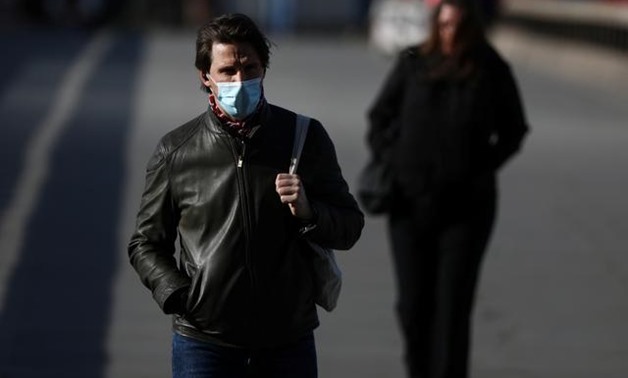
A man wearing a protective face mask walks along London Bridge following the outbreak of the coronavirus disease (COVID-19), London, Britain May 11, 2020. REUTERS/Simon Dawson
LONDON (Reuters) - The United Kingdom’s COVID-19 death toll topped 38,000 as of early May, by far the worst yet reported in Europe, raising questions about Prime Minister Boris Johnson’s handling of the coronavirus crisis.
Figures published by the Office for National Statistics for England and Wales brought the United Kingdom’s official death toll to 38,289 as of May 3 — up nearly 6,000 in the space of a week, according to a Reuters tally of death registrations data that also includes Scotland and Northern Ireland.
While different ways of counting make comparisons with other countries difficult, the figure confirmed Britain was among those hit worst by a pandemic that has killed more than 285,000 worldwide.
The data came a day after Johnson set out a gradual plan to get Britain back to work, including advice on wearing home-made face coverings — though his attempt to lift the coronavirus lockdown prompted confusion.
Such a high UK death toll increases the pressure on Johnson: opposition parties say he was too slow to impose a lockdown, too slow to introduce mass testing and too slow to get enough protective equipment to hospitals.
The data painted a grim picture in care homes, which have been especially hard hit by the virus.
“Care homes (are) showing the slowest decline, sadly,” ONS statistician Nick Stripe told BBC TV.
“For the first time that I can remember, there were more deaths in total in care homes than there were in hospitals in that week.”
Care homes now account for a third of all COVID-19 deaths in England and Wales.
A Reuters Special Report published last week showed care homes bore the brunt of policy designed to shield its hospitals from COVID-19, leaving many of the weakest exposed.
Unlike the daily death toll announced by the government, Tuesday’s figures include suspected deaths from COVID-19, the respiratory disease caused by the novel coronavirus.
In March, Britain’s chief scientific adviser said keeping deaths below 20,000 would be a “good outcome”. In April, Reuters reported that the government’s worst case scenario was a death toll of 50,000.
SICK MAN OF EUROPE?
Even after adjusting for population, Britain still ranks among the countries worst affected by the pandemic, a list that includes Belgium, Spain and Italy.
In Italy, the next worst-hit country in Europe and whose population is about 90% of Britain’s, the death toll stood at 30,739 as of Monday, according to a measure based solely on confirmed cases rather than suspected cases.
Broadly comparable British data on Monday showed 32,065 deaths.
Ministers dislike comparisons of the headline death toll because Britain’s performance in part reflects the fact that it has been quicker to publish comprehensive data on COVID-19 deaths than other European countries.
They say excess mortality - the number of deaths from all causes that exceed the average for the time of year - is more meaningful because it is internationally comparable.
Early evidence, though, suggests Britain is faring badly on that front too.
So far this year, there have been more than 50,000 excess deaths compared to a five-year average, ONS statistician Stripe said.
The ONS said deaths from all causes decreased for a second week running as of May 1, but 8,012 more people than average died in the 18th week of 2020.


Comments
Leave a Comment